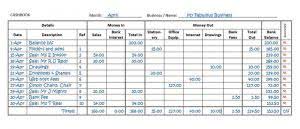Our QuickBooks Online comparison is based on our internal case study, explained below. As mentioned earlier, QuickBooks Solopreneur is excluded from our evaluation since it’s not a double-entry accounting software. Our internal case study compares the four standard QuickBooks Online plans for small businesses what quickbooks is best for a small business across major accounting categories and functions to help you decide which one fits your needs.
Buying tips for online versions of QuickBooks
The right priorities depend on your business size, industry, and growth plans—something I help clients assess before recommending specific solutions. However, Xero’s entry-level plan limits bills and invoices, which can be restrictive. In my implementation projects, I’ve found Xero requires a steeper learning curve but offers better collaboration features for teams.
Many of these products offer the same basic features, but they can differ in advanced functionality and build on less powerful versions. QuickBooks Online is the most versatile and well-rounded of the QuickBooks suite of products. Since it’s cloud based, QuickBooks Online is easy to access from any phone, tablet, or laptop.
QuickBooks reduces accounting legwork, but takes dedication upfront to setup properly. Make sure you or qualified staff actively use the capabilities for maximum ROI. Sales tax – Automatically calculate state and local sales tax on invoices. Invoicing – Easily create customized professional invoices and accept online payments.
We found this setup feature to be a nice value-add that other competitors we reviewed don’t offer. You can also speak to a QuickBooks representative directly for one-on-one guidance. During our evaluation, we discovered that QuickBooks Online’s extensive third-party integrations (750-plus) set it apart from many of its rivals. Instead of manually exporting and importing data between QuickBooks and your other business programs, you can automatically sync data between systems.
But choosing accounting services that meet your needs and budget can be challenging. This guide explores cloud-based accounting software costs and goes through what to look for, whether you’re a contractor with basic bookkeeping skills or an owner with several entities. We appreciate that QuickBooks Online uses bank-grade security to protect your data and that you can enable two-factor authentication. You can also set user permissions to control the access of employees you invite to the system. The software includes an audit log that tracks every login, logout and file change. We were impressed by QuickBooks Online’s automation tools, which stand above some competing platforms we reviewed.
The software automates tasks to reduce manual inputs, double entry and the chance for human error. Using our objective, data driven testing methodology, we’ve tested 300+ software. We dedicate ourselves to being objective in fully and fairly testing software, to get beyond the marketing fluff and truly understand the platform. Overall, QuickBooks remains a competitive choice for many business environments, particularly for those valuing simplicity and effective financial oversight. Self-Paced QuickBooks eLearning courses cost $300 at the starting point per student. QuickBooks Checking Account opening is subject to identity verification and approval by Green Dot Bank.
Small businesses need cost-effective accounting software that’s easy to use but still has the features they need to get the job done. Widely regarded as the top accounting software for small businesses, QuickBooks offers it all. With affordable pricing and various plans that suit businesses of different sizes, QuickBooks has elite features in packages that will suit a variety of businesses.
Zoho Projects
QuickBooks is not inherently HIPAA compliant, as it is not specifically designed to handle protected health information. Businesses in the healthcare sector should evaluate whether QuickBooks meets their compliance needs or consider additional measures to ensure HIPAA compliance. Lastly, in consideration of all the other criteria, we review the average price of entry-level plans against the core features and consider the value of the other evaluation criteria.
QuickBooks Pricing Plans Explained
I’ve personally implemented or tested each of these platforms with actual UAE businesses. While the UAE government doesn’t tax profits shared among business owners, health insurance coverage (costing approximately AED 1000 annually) is mandatory for all residents. To help her (and you), I tested 10 of the top QuickBooks project management tools that offer seamless integration. To find out which ones actually streamline workflows—not just on paper, but in real-world use. Track hours for employees and contractors, create schedules, and track mileage.
Which version of QuickBooks Self-Employed should I get?
QuickBooks Enterprise also offers much better customer support than QuickBooks Pro or QuickBooks Online with its Priority Circle customer support. QuickBooks Pro is locally-installed software with highly developed features like contact and lead management, expense tracking, project management, accounts payable, invoicing, and more. Essentials includes all 20-plus reports from Simple Start, such as cash flow statements, P&L, and balance sheets, plus over 20 additional reports. These standard reports include A/P and A/R aging details, expenses by vendor, and uninvoiced charges. Essentials also provides tools to analyze outstanding invoices and unpaid bills in greater detail, offering a clearer picture of your business finances.
Batch Invoicing
Pricing is based on the number of billable clients rather than the number of users. Many small business accounting services provide onboarding guides or in-app wizards that help new users set up their bookkeeping software. However, if you’re tracking inventory, adding payment processing, or customizing settings, prepare to spend several hours.
- You can also speak to a QuickBooks representative directly for one-on-one guidance.
- Small businesses often require the flexibility to access their accounting data from anywhere at any time.
- For example, if you are switching software providers, you may pay a data migration fee to transfer accounting or payroll data.
- It’s wise to look at a software company’s whole ecosystem of products before adopting a solution from it.
The downside of QuickBooks Online is that customer support is a bit lacking, and the subscription fee can be a bit expensive for smaller businesses in need of advanced features. The largest component of usability is the ability to find bookkeeping assistance when users have questions. This could be in the form of a bookkeeping service directly from the software provider or from independent bookkeepers familiar with the program. Other components of usability include customer service and ease of use. In addition to the basics of issuing invoices and collecting customer payments, we evaluated the software’s ability to create customized invoices.
- FedRAMP certification is typically required for cloud services used by the federal government to ensure they meet specific security standards.
- QuickBooks includes plenty of customization options, from the previously mentioned reports to invoice templates that can include your own business logos, branding, terms, and details.
- We wanted to see the ability to reconcile bank accounts with or without imported bank transactions and a list of book transactions that have not yet cleared the bank.
- However, QuickBooks Mac Plus does noticeably lack some of the features available on QuickBooks Online, including recurring invoices and live bank feeds.
- Ensure you can easily export your data if you ever need to switch platforms.
- If you have gone into business for yourself, you might consider investing in Solopreneur, as it can be the perfect solution for self-employed users.
QuickBooks Solopreneur is ideal for one-person businesses with limited bookkeeping knowledge or those needing to separate business and personal expenses. Our approach of simplifying complex accounting processes has helped countless UAE entrepreneurs focus on growing their businesses rather than getting lost in financial minutiae. I built ProfitBooks with straightforward export capabilities specifically because I believe your data belongs to you, not your software provider. Tally Prime is now available on mobile, allowing users to create and send invoices and reconcile bank transactions remotely. After years of working with UAE businesses and evaluating various accounting solutions, I’ve compiled this list of the best QuickBooks alternatives.
Yes, QuickBooks Online offers a mobile app that allows you to access your account, track expenses, create and send invoices, and more, all from your smartphone or tablet. Receipt capture and the ability to automatically generate bills from captured receipts were also part of our A/P evaluation. QuickBooks Essentials lets you track billable hours by job and assign them to specific customers, a feature not available in Simple Start.
Its ability to integrate with over 750 third-party apps also strengthens its value. By connecting accounting with e-commerce, CRM, and payroll systems, QuickBooks helps reduce duplicated data and streamline operations. Integration with tax platforms like TurboTax allows for smoother year-end filing, while accountant access ensures collaboration without the need for manual data exports. Our experts recommend Xero’s accounting software for small businesses. QuickBooks Enterprise supports up to 40 users, compared to Premier’s maximum of five. QuickBooks Enterprise also has a number of other useful features and tools you won’t find with Premier, such as a business plan creator.















